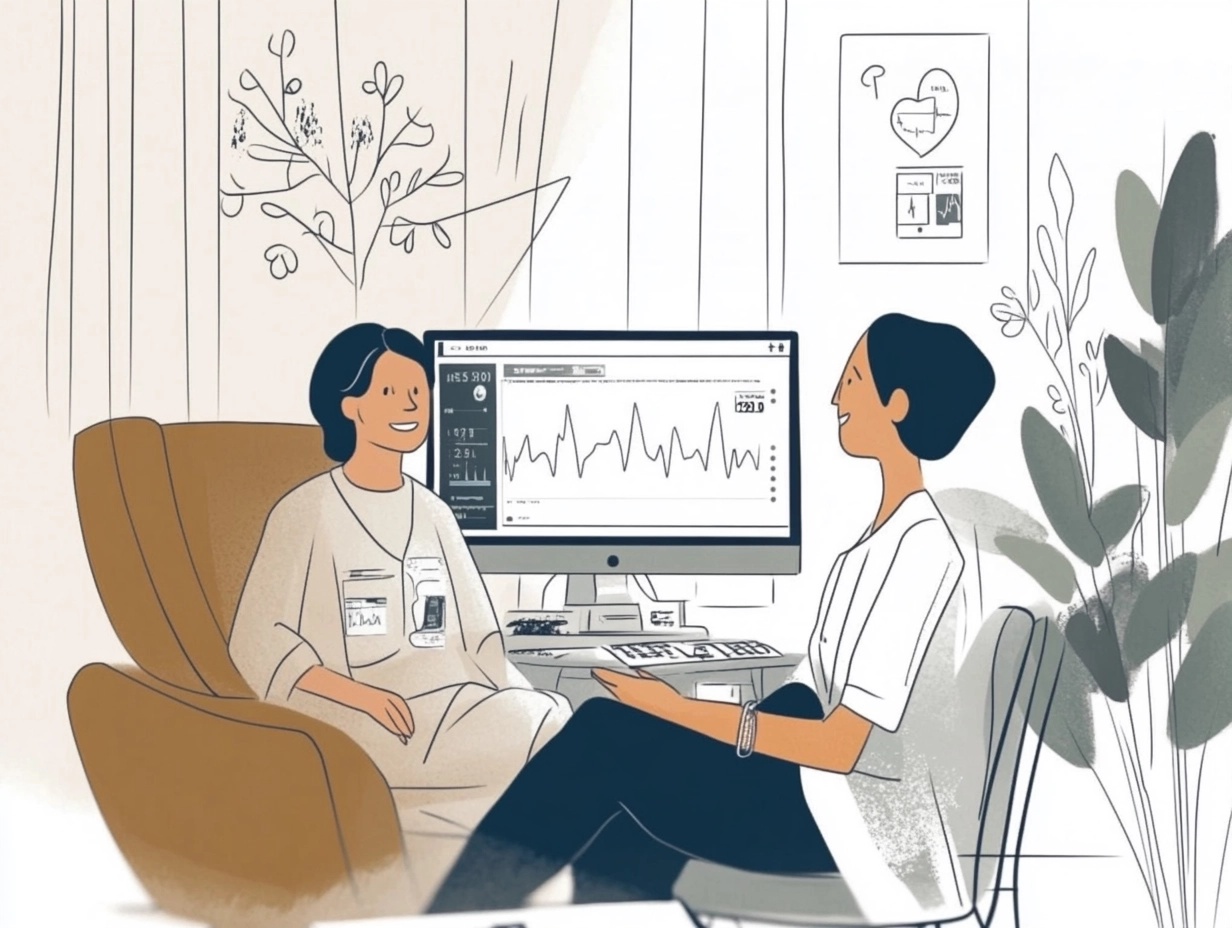I. Introduction
In today’s fast-paced world, managing stress and anxiety has become more important than ever before. Understanding and improving our physiological responses to stress can significantly contribute to our overall well-being. A crucial element in this endeavor is heart rate variability (HRV). While this may sound technical, HRV simply refers to the variation in time between each heartbeat – a key indicator of our body’s resilience and flexibility in the face of stress.
Biofeedback is a powerful tool in our wellness arsenal, offering us a unique opportunity to harness control over our body’s automatic functions. One specific type of biofeedback, HRV biofeedback, is making waves in the health and wellness industry, particularly for its potential to mitigate stress and anxiety.
As we delve into the world of HRV and biofeedback, we’ll explore the scientific principles behind these concepts, their implications for mental health, and how modern technology is making it more accessible for everyone. This comprehensive guide will give you insight into the intricacies of HRV biofeedback and its potential to help us lead healthier, less anxious lives. So, whether you’re a healthcare professional, a technology enthusiast, or someone interested in personal well-being, this HRV biofeedback guide is for you.
II. The Basics of HRV
What is HRV?
Heart Rate Variability (HRV) refers to the variation in time intervals between consecutive heartbeats. Contrary to popular belief, a healthy heart does not beat like a metronome. Rather, it dynamically adjusts its rhythm based on a variety of physiological and environmental stimuli. This variability is a critical measure of our body’s adaptability and resilience. High HRV generally indicates a healthy heart and a robust nervous system, while low HRV could suggest chronic stress, fatigue, or underlying health issues.
Factors Influencing HRV
Numerous factors can influence HRV, both positively and negatively. Lifestyle factors such as diet, exercise, sleep, and stress levels significantly affect HRV. Regular physical activity, a balanced diet, good quality sleep, and effective stress management can enhance HRV. On the contrary, excessive alcohol consumption, smoking, poor nutrition, and chronic stress can lower HRV. Additionally, medical conditions like heart disease and diabetes can also adversely impact HRV. Age is another important factor, as HRV generally decreases with age.
The Correlation between HRV and Overall Health
HRV serves as a key biomarker for overall health and well-being. High HRV is typically associated with better cardiovascular fitness, improved stress management, and overall wellness. It reflects the body’s ability to adapt to changes, manage stress, and recover from exercise. In contrast, low HRV often indicates a higher risk of cardiovascular disease, mental health issues, and even premature mortality.
Emerging research also suggests a correlation between HRV and cognitive functions like attention and memory. Therefore, HRV not only provides a snapshot of our physical health but also gives us insights into our mental and emotional state. Understanding and optimizing HRV can, thus, be a significant step towards achieving holistic health.
III. Understanding Biofeedback
Definition and Brief History of Biofeedback
Biofeedback is a technique that trains individuals to improve their health by controlling certain bodily processes that typically occur involuntarily, such as heart rate or blood pressure. The term was coined in the late 1960s and has roots in both western medicine and eastern practices. The aim of biofeedback is to create a greater awareness and control over our body’s functions, thereby improving health and performance.
Explanation of How Biofeedback Works
Biofeedback works by providing real-time data about the body’s functions. For instance, sensors or electrodes placed on the skin can measure heart rate, muscle tension, temperature, brainwaves, and other physiological parameters. These measurements are usually displayed on a monitor. As individuals see their physiological responses, they can learn to control them using various relaxation or visualization techniques. For example, when stressed, heart rate increases; biofeedback can help individuals recognize this and learn strategies to decrease heart rate, thereby reducing stress.
Types of Biofeedback Techniques Including HRV Biofeedback
There are several types of biofeedback, each focusing on a different physiological function:
- Thermal biofeedback: Measures skin temperature
- Electromyography (EMG): Monitors muscle tension
- Neurofeedback or EEG Biofeedback: Measures brainwave activity
- Biofeedback for respiration: Monitors breathing patterns and rate
- HRV Biofeedback: Tracks the variation in intervals between heartbeats
HRV biofeedback is particularly interesting because of its potential to improve mental and physical health. By learning to modify physiological responses, such as heart rate patterns, individuals can enhance their HRV, improve stress management, and even alleviate conditions such as anxiety. It’s an exciting demonstration of how technology can empower us to take control of our own health and wellness.
The Connection between HRV and Anxiety
Overview of Anxiety as a Health Condition
Anxiety is a widespread health condition, characterized by feelings of worry, fear, or apprehension that are strong enough to interfere with one’s daily activities. While it’s normal to experience occasional anxiety, chronic or excessive worry can significantly impact quality of life. Symptoms can range from physical manifestations like increased heart rate, rapid breathing, and restlessness, to emotional symptoms such as persistent worrying, concentration difficulties, and sleep disruptions.
Scientific Evidence Showing the Relationship between Low HRV and Anxiety
Several studies have linked low HRV to anxiety disorders. HRV serves as an index of the nervous system’s flexibility in managing stress and emotional turmoil. Lower HRV typically implies reduced regulatory capacity of the nervous system and diminished ability to adapt to stress – a hallmark of anxiety disorders. Research shows that individuals with anxiety disorders often exhibit lower HRV compared to those without, suggesting that HRV may be a reliable biological marker for anxiety.
Benefits of Improving HRV for Managing Anxiety
Improving HRV could potentially alleviate anxiety symptoms. Enhanced HRV implies better autonomic nervous system balance and improved ability to regulate physiological responses to stress, thereby reducing anxiety levels. Techniques like HRV biofeedback can help individuals understand their physiological responses and learn to modulate them for improved emotional and mental well-being. By providing real-time feedback on HRV, individuals can learn to implement relaxation techniques, thereby improving HRV and mitigating anxiety. Additionally, HRV biofeedback can promote a sense of control over anxiety, providing further psychological benefits. Overall, improving HRV appears to be a promising approach in managing anxiety.
The Role of Vagal Tone in HRV and Anxiety
Explanation of the Vagus Nerve and Vagal Tone
The vagus nerve is the longest cranial nerve, extending from the brain to the abdomen, and touching various organs like the heart and lungs. As part of the parasympathetic nervous system, the vagus nerve plays a crucial role in controlling the ‘rest and digest’ functions of the body, and maintaining heart rate and blood pressure.
Vagal tone refers to the activity of the vagus nerve. Higher vagal tone is associated with better control of body functions during stress and improved capacity to relax after stress.
The Impact of Vagal Tone on HRV
The vagus nerve has a direct impact on heart rate variability. It can slow down the heart rate and increase the variability between heartbeats, thus increasing HRV. Conversely, lower vagal tone often results in lower HRV, as there is less regulatory influence over heart rhythms. Therefore, improving vagal tone is one way to enhance HRV and, by extension, improve stress resilience.
Importance of Vagal Tone in Anxiety and Mental Health
There’s growing evidence that vagal tone is integral to mental health. Individuals with higher vagal tone typically show better stress management, emotional regulation, and social bonding – all crucial aspects of mental health. On the contrary, lower vagal tone has been linked to mental health issues, including anxiety disorders.
By activating the vagus nerve, we can increase vagal tone and subsequently improve our body’s ability to manage stress. Techniques that stimulate the vagus nerve, such as deep breathing, yoga, and even laughter, can enhance vagal tone, boost HRV, and potentially reduce anxiety symptoms, underscoring the significant role of vagal tone in both HRV and mental health.
How HRV Biofeedback Works
The Science behind HRV Biofeedback
HRV biofeedback revolves around the principle of modifying physiological processes through feedback and practice. It uses real-time measurements of heart rate variability to provide individuals with information about their body’s physiological responses. By observing HRV in real-time, individuals can learn to modify their heart rate patterns through guided breathing exercises, mindfulness, or other relaxation techniques, thereby improving HRV and the body’s stress response.
Understanding the Role of Wearables in HRV Biofeedback
Wearable technology has revolutionized HRV biofeedback by making it more accessible. HRV wearables, like smartwatches and fitness bands, can continuously monitor heart rate and calculate HRV. By delivering real-time data, these devices enable individuals to see the immediate impact of stress and relaxation on their HRV. Many wearables also provide guided exercises for improving HRV, making it easier for individuals to integrate HRV biofeedback into their daily lives.
Benefits of Using HRV Biofeedback
Using HRV biofeedback has multiple benefits. It can enhance self-awareness of physiological stress responses, and help individuals develop effective strategies to manage stress and improve relaxation. Improved HRV, through biofeedback, can lead to better emotional regulation, improved cognitive performance, and overall better mental health. Additionally, by enhancing the balance of the autonomic nervous system, HRV biofeedback may help mitigate conditions like anxiety and depression, improve sleep quality, and boost overall wellbeing. Given its non-invasive nature and potential health benefits, HRV biofeedback is a promising tool for health improvement and stress management.
VII. Practical Application: Using HRV Wearables for Biofeedback
Introduction to HRV Wearable Technology
HRV wearable technology refers to devices such as smartwatches and fitness bands that measure heart rate variability. These devices use either electrocardiography (ECG) or photoplethysmography (PPG) technology. ECG uses an electrical voltage signal produced by heart activity to measure HRV. Our nerve and muscle cells communicate with each other using electrical and chemical signals, which also control our heartbeat. This electrical wave throughout our body can be measured on the surface of our skin using electrodes with gel, which help conduct readings of the electrical signals. Note that no electricity is sent into the body in order to conduct these readings. Rather, ECG devices measure changes in voltage on different areas of the skin and plot them on a graph. Thus, an electrocardiograph is literally a visual representation of the electrical signals originating from our heart.
In contrast, PPG technology uses lights and sensors to measure blood volume changes in our cardiovascular system, especially the veins and capillaries under our skin. To measure heart rate using PPG technology, an LED shines a constant light onto our skin, some of which is reflected and scattered back into a semiconductor device that converts light into an electrical current, called a photodiode. As our heart beats and sends a pulse throughout our cardiovascular system, the amount of light that reaches the photodiode changes due to pressure changes. Photoplethysmography technology tracks these changes in light and the time between pulses to determine our heart rate.
ECG technology is considered the gold standard when measuring HRV. Unlike PPG, which is an indirect method, ECG records the heart’s electrical activity at its source, which makes it more reliably accurate at the millisecond level. ECG technology enables heart rate to be measured accurately on a beat by beat basis, so that meaningful HRV data can be obtained with short-duration measurements. The primary limitation is that ECG readings must be conducted close to the heart, which doesn’t allow for a diverse range of wearable devices other than a patch or a strap worn on the chest.
In contrast, PPG technology can theoretically be taken anywhere from the body (e.g., the wrist, finger, earlobe, temple, etc.), allowing for more flexibility in terms of types of wearable devices. Since individuals are generally more familiar with the idea of wearing a watch-like device (e.g., FitBit, Apple Watch), this could be a shortcut decision-making factor for some. However, the limitations of PPG technology are significant. PPG is accurate for measuring HRV in healthy individuals who are at rest, but quickly loses accuracy when any physical activity is introduced. Thus, in order to be accurate, PPG measurements must ideally be taken overnight while the wearer is asleep. This significantly limits access to a more holistic picture of one’s HRV data, and prevents wearers from tracking how different activities throughout the day impact their HRV.
Furthermore, PPG technology is more likely to be missing data. This is because PPG sensors require a relatively long settling time due to the need for cancelling the effects of ambient light, accommodating different skin conditions and colors, and dealing with motion artifacts. Additionally, PPG can only be used on parts of the body that have a high concentration of blood vessels, making it challenging to get a reliable PPG signal from certain parts of the body, like the wrist. For example, a study found that around 10% of beats could not be detected by the Apple Watch in both the relax and stress stages. This would not be so problematic if they were isolated beats, but they tended to be consecutive beats, which resulted in significant gaps in the data. Due to these limitations, using PPG technology to measure HRV can result in missing important information that could help individuals improve their mental and physical health.
How to Use HRV Wearables for Biofeedback
Using HRV wearables for biofeedback is straightforward. Once the wearable is set up and synchronized with the respective app on a smartphone or computer, it starts tracking heart rate data and computing HRV. Many apps provide real-time visual feedback of HRV and guided exercises to improve it. By following these exercises, users can learn to control their physiological responses, improve their HRV, and thereby better manage their stress levels.
Case Studies Showcasing the Benefits of HRV Wearables in Managing Anxiety
Multiple case studies have demonstrated the benefits of HRV wearables in managing anxiety. For instance, a study published in the journal “Applied Psychophysiology and Biofeedback” found that participants using HRV biofeedback showed significant reductions in self-reported stress and anxiety levels. Another study published in “Frontiers in Psychiatry” reported that participants with generalized anxiety disorder experienced reduced anxiety symptoms after using HRV biofeedback daily for four weeks. These studies underscore the potential of HRV wearable technology as a practical tool for managing anxiety.
VIII. Future Perspectives of HRV Biofeedback Technology
Current Trends in HRV Biofeedback Technology
The world of HRV biofeedback technology is continually evolving. Modern HRV wearables are becoming more sophisticated and user-friendly, providing not only accurate data but also intuitive interfaces. They are equipped with powerful sensors and complex algorithms that can detect even the slightest changes in heart rate variability. Additionally, these devices are increasingly integrating features such as guided breathing exercises and stress management techniques, further enhancing their role in personal health management.
Future Implications and Potential Advancements in the Field
The future of HRV biofeedback technology holds much promise. As research on the importance of HRV continues to grow, so too does the potential for technological advancements in this field. We can expect to see more personalized devices that can tailor biofeedback exercises based on individual data, improving their efficacy in managing stress and anxiety.
Moreover, the integration of AI and machine learning in HRV biofeedback apps will further refine the user experience, providing personalized feedback and interventions, while also identifying patterns and trends that may signal underlying health issues.
We also foresee a future where HRV biofeedback technology is not just used for personal health management, but is also adopted in clinical settings for patient monitoring and treatment, given its potential to provide insightful and real-time health data.
In essence, HRV biofeedback technology is poised to play a significant role in preventive healthcare, personal wellness, and the future of medicine.
IX. Conclusion
As we have learned, Heart Rate Variability (HRV) is a powerful biomarker of overall health, reflecting our body’s ability to manage stress and maintain balance. Low HRV is linked to anxiety and other mental health issues. HRV biofeedback, especially when facilitated by wearable technology, is an effective tool in managing anxiety, enhancing our ability to regulate physiological responses to stress.
Harnessing the potential of HRV biofeedback could be the key to improved mental and physical wellbeing. So, why not give it a try? Exploring HRV biofeedback might be the first step towards gaining greater control over your health, managing anxiety better, and improving your overall quality of life. Remember, technology is not just about making life easier – it’s about making life healthier, too.
References
- Thayer, J. F., Åhs, F., Fredrikson, M., Sollers III, J. J., & Wager, T. D. (2012). A meta-analysis of heart rate variability and neuroimaging studies: implications for heart rate variability as a marker of stress and health. Neuroscience & Biobehavioral Reviews, 36(2), 747-756.
- Lehrer, P. M., & Gevirtz, R. (2014). Heart rate variability biofeedback: how and why does it work? Frontiers in Psychology, 5, 756.
- Kim, H. G., Cheon, E. J., Bai, D. S., Lee, Y. H., & Koo, B. H. (2018). Stress and Heart Rate Variability: A Meta-Analysis and Review of the Literature. Psychiatry Investigation, 15(3), 235–245.
- Goessl, V. C., Curtiss, J. E., & Hofmann, S. G. (2017). The effect of heart rate variability biofeedback training on stress and anxiety: a meta-analysis. Psychological Medicine, 47(15), 2578-2586.
- Appelhans, B. M., & Luecken, L. J. (2006). Heart rate variability as an index of regulated emotional responding. Review of General Psychology, 10(3), 229–240.
- Mather, M., & Thayer, J. F. (2018). How heart rate variability affects emotion regulation brain networks. Current Opinion in Behavioral Sciences, 19, 98-104.
- Chalmers, J. A., Quintana, D. S., Abbott, M. J., & Kemp, A. H. (2014). Anxiety disorders are associated with reduced heart rate variability: a meta-analysis. Frontiers in Psychiatry, 5, 80.
- Lehrer, P., Vaschillo, E., & Vaschillo, B. (2000). Resonant frequency biofeedback training to increase cardiac variability: Rationale and manual for training. Applied Psychophysiology and Biofeedback, 25(3), 177–191.
- Porges, S. W. (2007). The polyvagal perspective. Biological psychology, 74(2), 116-143.
- Van Diest, I., Verstappen, K., Aubert, A. E., Widjaja, D., Vansteenwegen, D., & Vlemincx, E. (2014). Inhalation/exhalation ratio modulates the effect of slow breathing on heart rate variability and relaxation. Applied Psychophysiology and Biofeedback, 39(3-4), 171–180.
- Laborde, S., Mosley, E., & Thayer, J. F. (2017). Heart Rate Variability and Cardiac Vagal Tone in Psychophysiological Research – Recommendations for Experiment Planning, Data Analysis, and Data Reporting. Frontiers in Psychology, 8, 213.
- Shaffer, F., & Ginsberg, J. (2017). An Overview of Heart Rate Variability Metrics and Norms. Frontiers in Public Health, 5, 258.





Leave a Reply
You must be logged in to post a comment.